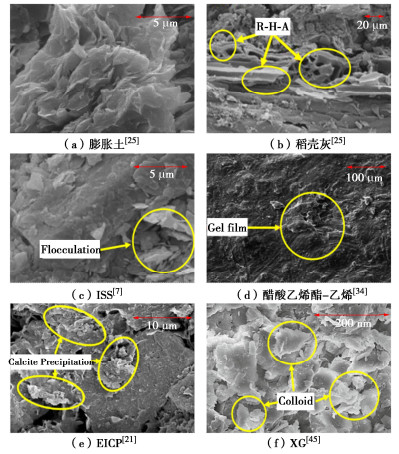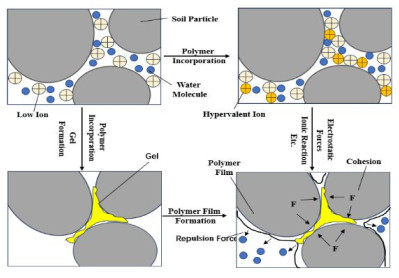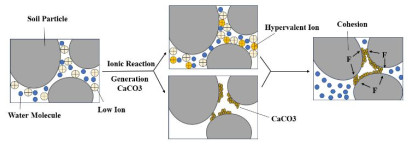Research progress in ecological treatment of expansive soil
-
摘要: 膨胀土是一种遇水急剧膨胀变形、失水迅速收缩开裂的问题土,需对其进行治理以满足工程要求。对近年来新发展的膨胀土生态治理材料进行了归纳、总结,并根据其组分、特点分为地聚合物类、离子固化剂、有机高分子材料类、微生物与酶类和生物胶类,并阐述了各类固化剂的材料特点、固化效果及作用机理,均符合新时代发展要求,可作为一种可持续的、环保的、多功能的技术大范围推广应用,最后从生态治理和推广应用角度探讨了目前需要克服的问题。Abstract: The expansive soil is a kind of problematic soil that rapidly expands and deforms when encountering water and rapidly shrinks and cracks when losing water. It needs to be treated to meet the engineering requirements. The newly developed ecological treatment materials for the expansive soil in recent years are summarized and categorized, and the are classified according to their components and characteristics into-geopolymer, ion curing agent, organic polymer material, microorganism and enzyme, and biopolymer. The material characteristics, treatment effectiveness, and stabilization mechanisms of various treatment materials are elaborated, and they all meet the requirements of the new era and can be widely promoted and applied as a sustainable, environmentally friendly and versatile technology. Finally, the urgent issues that need to be addressed from the perspectives of ecological governance and promotion are discussed.
-
0. 引言
非饱和土在世界各地的工程实践中均有涉及,土体的抗剪强度随含水率或吸力的变化对岩土结构的稳定性至关重要[1-3]。基质吸力与含水率或者饱和度之间的关系被称之为土水特征曲线(soil-water characteristic curve, SWCC)或者土体持水曲线(soil-water retention curve, SWRC)。SWRC是体现非饱和土力学本构关系特征的重要响应曲线,其对土体的非饱和抗剪强度有显著影响[4-7]。
不同非饱和土的微细观测试分析表明[8],SWRC受到孔径分布特征的影响,大致可区分为单峰SWRC和双峰SWRC。Cai等[9]针对桂林红黏土联合轴平移技术、滤纸法和盐溶液蒸汽平衡法进行了宽广吸力范围内的持水特性试验,结果表明压实样呈现双孔隙结构,并具有双峰SWRC,而预固结试样呈现单一孔隙和单峰SWRC。Satyanaga等[10]针对砂土和高岭土的混合物进行了一系列水力特性的测定试验,指出具有双孔隙结构的土体不一定呈现双峰SWRC,但双峰SWRC出现的必要条件是具备双孔隙结构。已有数据表明间断级配土体、粗砂-砾石混合物以及压实黏土等易呈现双峰SWRC。
过往的大量试验研究了抗剪强度随吸力的演化规律,其中土样普遍为具有单一孔径结构或单峰SWRC的土体。如张俊然等[11]利用轴平移技术和盐溶液蒸汽平衡法对吸力范围在38 MPa内的南阳膨胀土进行了一系列常吸力三轴剪切试验,分析了峰值抗剪强度的演化规律并提出了预测模型;张季如等[12]对不同应力路径下钙质砂抗剪强度进行了试验研究与机理分析;徐筱等[13]对高吸力下黏性土的抗剪强度进行了三轴试验研究;Gao等[14-15]研究了不同制样方法和不同初始干密度对非饱和土应力应变关系的影响。试验结果和理论分析表明吸力和强度之间往往呈现非线性关系[4, 16-17]。对于粗粒土,利用SWRC将吸力乘以饱和度,孔隙应力扩为宏观应力时,强度包络线呈现直线特征,这是因为此时的宏观应力是有效应力的一部分。对于细粒土,毛细部分对剪切强度起主导作用[6-7, 16, 18-19],故而吸力乘以毛细饱和度才是骨架应力,或者有效应力的一部分。已有大量研究表明,结合上述有效应力,极限剪应力的临界状态线可以由唯一的强度包络线表征,即存在一组适用于饱和与非饱和状态的相同强度参数[5-7, 20]。以上结论仅在具有单峰SWRC的土体中得到过验证。
近期对于具有双孔隙结构,特别是具有双峰SWRC土体力学特性的相关试验在陆续开展。Zhao等[21]对间断级配粗粒土进行了低吸力段的三轴试验,并将其应力应变行为分为4个阶段;Ng等[22]对具有双峰SWRC的压实黄土试样进行了一系列控制吸力的直剪试验。但上述土体的吸力-强度特性和具有单峰SWRC的土体能否统一还未有相关研究。
本文研究对象为同时具有双孔隙结构及双峰SWRC的土体(不仅限于压实膨胀土)。联合轴平移技术和盐溶液蒸汽平衡法在宽广吸力范围内对内乡膨胀土压实样进行了一系列的非饱和三轴剪切试验,探讨不同吸力对土体应力-应变行为及抗剪强度的影响特性。采用双峰SWRC模型区别毛细和吸附的影响效应,进而在毛细吸应力空间(毛细饱和度乘以吸力)分析土体的非饱和峰值抗剪强度,并利用双孔隙结构土体水力特性试验成果对峰值强度分析方法作评价与验证。
1. 试验概述
1.1 试验材料
本试验选用膨胀土取自河南内乡县张岗村以西200 m处,是内乡220 KV变电站拟选站址,取土深度为地下5 m范围,天然干密度为1.69 g/cm3,天然含水率为22.74%。经过X射线衍射分析,内乡膨胀土的主要矿物成分为石英、黏土矿物,其次为斜长石和微斜长石。砂粒的含量为9.97%,粉粒含量为56.77%,黏粒含量为33.26%。粒径大于0.075 mm的颗粒质量为总质量的9.97%,小于50%,按照土的工程分类标准可判断该土样为细粒土,其它物理特性指标可见表 1。内乡膨胀土颗粒分布曲线如图 1所示,根据颗粒分布曲线及塑性指数,可知其为低液限黏土(CL)。
表 1 内乡膨胀土基本物理指标Table 1. Index properties of Neixiang expansive soil颗粒相对质量密度 液限/
%塑限/
%最大干密度/
(g·cm-3)最优含水率/% 自由膨胀率/% 2.74 45.1 25.3 1.70 21.2 59 1.2 孔径分布与持水特性
较早开展的压汞试验表明[23],内乡膨胀土的重塑预固结试样具有单峰孔径分布;与之不同的是,重塑压实样的微观结构为双孔隙结构,由集聚体间的大孔隙和集聚体内的小孔隙组成(如图 2(a))。联合轴平移技术(0~200 kPa)、滤纸法(200~8 MPa)和饱和盐溶液蒸汽平衡法(3.29~198.14 MPa)进行了宽广吸力范围的持水特性试验[23]。结果显示,预固结样的持水曲线呈现单峰形态。压实样具有双峰持水曲线,即由两段斜率陡峭的曲线组成(双“S”分布),呈对数坐标下的两段半正态分布形式,中间有明显过渡区或者平台段。同时曲线上包括两个进气值AEV1和AEV2(分别对应空气进入到集聚体间和集聚体内孔隙时的孔隙气压力)以及两个残余饱和度R1和R2(如图 2(b))。本文进行三轴试验的试样为内乡膨胀土压实样,具有双孔隙结构和双峰持水曲线。
1.3 非饱和三轴试验方法
将自然风干土通过碎土机打碎,过2 mm筛,配制目标含水率为24%的湿土,放入密闭容器中静置两周待水分均匀后取用。试验采用击实法在三开模中制样,分为6层击实以保证均匀性,每一层通过175 g的落锤从300 mm的高度落下。试样直径38 mm,高76 mm,并控制其初始干密度为1.40 g/cm3。
三轴试验采用HKUST双压力室的GDS UNSAT非饱和土三轴仪进行(如图 3),其压力室的底座嵌着进气值为500 kPa的陶土板。差压传感器(DPT)和HKUST双压力室(double-cell)系统量测非饱和土试样的体积变化。试验前进行标定,以消除非饱和土三轴试验系统中体变量测的系统误差。
为了实现全吸力范围抗剪强度的测定,联合采用轴平移技术法(0~500 kPa)和饱和盐溶液蒸汽平衡法(3.29~198.14 MPa)进行宽广范围吸力的控制。低吸力试验中,利用饱和陶土板的过水不过气的功能控制低吸力,同时轴平移技术避免孔隙水气化。应力路径如图 4所示,从初始状态开始,首先施加σ3n=20 kPa,s=100,200 kPa进行吸力平衡(ABi),吸力平衡之后施加σ3n=200 kPa进行固结平衡(BiCi),变形稳定之后在恒定围压和吸力值下进行控制应变速率的三轴排水剪切(CiDi)。
高吸力试验中,利用饱和盐溶液来控制密封干燥皿内空气的相对湿度[13, 24-26],从而控制土体的总吸力,不同的饱和盐溶液对应的吸力值见表 2[9, 25-26],在不考虑渗透吸力的情况下,总吸力近似等于基质吸力。依据每小时体积变化量小于0.01 cm3的平衡标准[11, 13-14],该过程耗时3~4个月。吸力平衡后把试样装在非饱和土三轴试验仪上,进行常含水率下的固结平衡和三轴剪切,此时可认为是等吸力试验[11, 13, 26]。试样顶部通过孔隙气压控制管路和大气连通,试验中保证孔隙气压为0。采用不透水塑料薄膜将陶土板和试样隔开,保证含水率不变[11, 13]。应力路径如图 4所示(仅展示控制吸力为3.29,21.82 MPa的路径),从初始状态开始,首先利用饱和盐溶液进行高吸力平衡(AXi),吸力平衡之后施加围压σ3n=200 kPa进行固结平衡(XiYi),变形稳定之后在恒定围压和常含水率下进行控制应变速率的不排水(排气)剪切(Yi Zi)。
表 2 饱和盐溶液及对应的吸力值Table 2. Saturated salt solutions and corresponding suctions饱和盐溶液 RH/% 总吸力/MPa K2SO4 97.6 3.29 Na2SO3·7H2O 90.8 13.10 KCl 85.1 21.82 NaCl 75.5 38.00 NaBr 59.1 71.20 K2CO3 43.2 113.50 CH3COOK 23.1 198.14 吸力平衡和固结平衡的标准根据进每2 h出水量小于0.01 cm3和每2 h体积变化量小于0.02 cm3确定。采取轴向应变控制三轴剪切加载模式。相关学者对宽广吸力范围内不同三轴剪切速率对峰值强度和体变的影响做了相关研究[11, 27-28],本试验选取轴向剪切速度约为0.00192 mm/min,保证剪切中孔隙水压完全消散。
2. 非饱和三轴试验结果
本文对重塑压实膨胀土样进行了不同吸力水平下的9组试验,图 5显示不同常吸力下,三轴剪切过程中的应力应变关系和体变结果(压缩为正,剪胀为负)。结果表明,低吸力条件下(s=100 MPa,s=200 kPa)以及中吸力条件下(s=3.29 MPa,s=13.1 MPa),应力应变曲线呈现硬化现象,同时有明显的剪缩行为。随着吸力增加,剪缩体变逐渐减小。
高吸力条件下(s为21.82,38,71.2,113.5,198.14 MPa),应力应变曲线呈现峰值后软化现象,试样开始在经历了1%~3%的体积收缩变形之后开始出现明显剪胀。在高吸力状态下(s=113.5 MPa,s=198.14 MPa),试样在较小应变的情况下很快达到峰值强度,随后软化至大应变时偏应力急剧降低。
随着吸力的增加,剪胀性逐渐增加(或剪缩性减弱)。应力应变曲线的峰后软化现象及体积剪胀现象可以归因于试样失水后孔隙比减小明显(特别是大孔隙收缩[27])或过度固结的应力历史[11]。
图 5中应力应变关系存在峰值,则峰值抗剪强度取偏应力最大值;若应力应变关系不存在峰值,则峰值抗剪强度取轴向应变为15%处的偏应力作为峰值抗剪强度(如图 6)。在吸力s小于21.82 MPa时,峰值和残余偏应力均增加,特别是在吸力s介于200 kPa至21.82 MPa之间增幅较大。在吸力s大于21.82 MPa时,峰值偏应力继续增加,残余偏应力开始下降。这是由于在恒定围压条件下,超过峰值剪应力的连续剪切形成的剪切带严重破坏了土体颗粒接触周围的空气-水弯液面系统,因此吸力对峰值强度的贡献往往大于残余状态。
除了外部载荷外,吸力的增加往往会在土体颗粒的接触点上施加表面张力以及吸附作用,从而在土体颗粒之间产生额外的黏结,使土壤结构变得更加坚硬,在剪切过程中表现出脆性。以脆性指数评估土体脆性大小的方法如下[29-30]:
IB=qpeak−qrqr。 (1) 式中:qpeak为峰值抗剪强度;qr为残余抗剪强度。
从图 6,7可以清楚地看到试件的脆性随吸力的增加而增长,表明剪切破坏后破坏区域逐渐过渡,即在中低吸力下呈桶形或中心鼓形的延性破坏模式,在高吸力下发生应变局部化现象,并产生明显的剪切破坏面。此外,脆性增加了峰后软化的幅度,表现为图 6中峰值偏应力与残余破坏状态之间的差值增大。
3. 峰值抗剪强度的分析与讨论
Bishop[31]提出了经典的非饱和土有效应力公式:
σ′ij=σij−uaδij+χsδij, (2) 式中:σij为总应力张量;ua为孔隙气压力;χ为有效应力参数,s为基质吸力;δij为Kronecker符号。
式(2)的有效应力参数χ最初采用饱和度Sr加以量度,这种做法由于高估了吸力对骨架应力的作用,忽视了吸附吸力的存在[5-7, 16, 18-20],导致预测的峰值抗剪强度往往大于实际强度,特别是对于细粒土以及低饱和度的情况。为此,近来一些研究发现,可将总饱和度Sr的量度替换成毛细饱和度Scapr[5-7, 20, 32-33]以区分毛细和吸附不同作用的影响:
σ′ij=σij−uaδij+Scaprsδij。 (3) 研究表明,结合上述有效应力,极限剪应力的临界峰值强度状态线可以由唯一的强度包络线表征[5-7, 20](如图 8(a),即存在一组适用于饱和与非饱和状态的相同强度参数。唯一的强度包络线不仅在低吸力适用,也在高吸力范围内得到了验证,同时对于粗粒土和细粒土显示具有线性特征[34]。
需要注意的是,以上研究仅针对大量具有单峰持水曲线的土体,而没有涉及具有双峰持水曲线的土体。这里利用笔者[5, 20, 23, 32]提出的可以区分毛细和吸附饱和度的双峰持水曲线模型来计算毛细饱和度:
Scapr=(1−α)A+(α−αC(1−B)1−C(B−1))B, (4) A=12erfc(ln(s/sm1)√2ζ1), (5) B=12erfc(ln(s/sm2)√2ζ2), (6) C=β(1−lnslnsd)。 (7) 式中:sm1为集聚体间中值孔径对应的基质吸力(kPa),sm2为集聚体内中值孔径对应的基质吸力(kPa);ζ1为表征集聚体间孔径分布宽度的无量纲参数,ζ2为表征集聚体内孔径分布宽度的无量纲参数,erf( )为误差函数;α=θs2/θs1,θs1为第一进气值对应的含水率,即土材料完全饱和时的体积含水率,θs2为第二进气值对应的含水率,即集聚体内的饱和含水率;β为表征吸附作用大小的材料参数;sd为干燥情况下的最大吸力,取sd=106(kPa)。
参数α代表两种大小孔隙结构相对大小,技术上可以根据压汞试验进行标定。参数β控制了吸附水在最大吸力处的变化速率,可以通过检测吸附水含量的变化确定,技术上可以通过核磁共振技术实现[35]。参数sm(sm1,sm2)代表中等孔径对应的吸力值,ζ(ζ1,ζ2)是对数坐标下孔径的标准差,这些参数可以通过微观试验,例如压汞试验进行测定[36]。以上参数的标定方法都是基于相应的微观试验或者这些参数直接控制的测试结果来确定。然而,在未进行微观试验的状况下,模型参数可以通过对持水数据的拟合获得,即基于非线性拟合(详细的讨论见文献[37])的方法进行,相同的参数标定流程见笔者对双峰持水曲线的建模过程[23]。
图 8(b)表明,利用相同的表征方法利用毛细饱和度将吸力从孔隙应力扩为宏观应力时(参数见表 3,其中α,β,ζ1,ζ2为无量纲参数),强度包络线由两条直线段组成,这一强度特征的微细观机理可解释为:由于具有双峰持水曲线的土体常存在集聚体结构,集聚体间大孔隙以毛细水占主导,集聚体内小孔隙赋存吸附水。对于毛细水,来源于空气-水弯液面提供的表面张力,能够在骨架间进行应力传递,完全贡献了第一段直线的强度;吸附作用主要源于3种不同的物理化学机制[38-40],即离子水化、内表面水化及颗粒表面水化,离子水化来源于原子尺度的电子力作用,内表面水化和颗粒表面水化受到范德华力影响。此种物理化学作用虽不能形成骨架应力,往往会产生额外的胶结作用,从而增加土体的第二段抗剪强度[27]。
表 3 双峰持水曲线模型参数Table 3. Parameters of bimodal water-retention curveNg等[22, 27]对具有双峰SWRC的压实黄土试验进行了宽广范围的直剪试验;Satyanaga等[10]对砂土和高岭土不同配比的混合物M3(70%砂土、30%高岭土)、M5(50%砂土、50%高岭土)、M6(40%砂土、60%高岭土)以及M8(20%砂土、80%高岭土)利用轴平移技术进行了三轴剪切试验;孙德安等[42-43]对桂林红黏土进行了一系列土水特性试验和控制吸力的直剪试验,测试土体的基本物理指标见表 4,双峰SWRC的模型参数见表 3。基于土体持水特性和剪切试验的试验结果,在毛细吸应力空间重新整理峰值抗剪强度值(如图 9),结果显示强度随毛细吸应力的变化均由双段直线组成,第二段直线位于第一段直线的上方。这种现象的产生机理可同样归因于:对于具有双孔隙结构的土体,其持水曲线呈现双峰形态,高吸力下的峰值抗剪强度不仅由毛细作用形成的空气-水弯液面提供,还受到吸附作用引起的胶结作用增强。
表 4 具有双峰持水曲线土体的基本物理指标Table 4. Physical properties of soils with bimodal SWRC试验数据和理论研究表明,对于具有双孔隙结构的土体,在集聚体间(低吸力范围),用毛细饱和度乘以吸力将吸力从孔隙应力扩为宏观应力时,能更为合理地量度吸力对有效应力的贡献;在集聚体内(高吸力范围),此时除毛细吸应力贡献峰值抗剪强度之后,还受到结构重组和胶结作用的影响(铁和锰氧化物的胶结[27])。后续研究需要考虑双孔隙结构以及胶结作用对抗剪强度的影响特性。
4. 结论
本文针对具有双孔隙结构及双峰SWRC的非饱和重塑膨胀土的抗剪强度开展了试验及理论研究。联合轴平移技术和盐溶液蒸汽平衡法对宽广吸力范围内膨胀土压实样进行了一系列的非饱和三轴剪切试验。同时对峰值抗剪强度在毛细吸应力空间(毛细饱和度乘以吸力与偏应力)进行了分析讨论。得到以下4点结论。
(1)中低吸力下的应力应变关系为应变硬化,伴随着剪缩行为,试样呈现中心鼓形的延性破坏模式;高吸力下为应变软化,伴随着剪胀现象,试样有明显的破坏剪切带。
(2)脆性随吸力的增加而增长,表现为峰后软化的幅度增大,即峰值抗剪强度与残余抗剪强度之间的差值增大。
(3)毛细吸应力能更为合理地揭示吸力对剪切强度的贡献,在毛细吸应力-强度空间,双孔隙结构非饱和土(不仅限于压实膨胀土)均呈现双段线性的强度特征。
(4)低吸力范围内,双孔隙结构非饱和土的抗剪强度由饱和强度与毛细吸应力贡献;高吸力范围内,抗剪强度应由饱和强度、毛细吸应力与胶结作用提供。
-
-
[1] 冷挺, 唐朝生, 徐丹, 等. 膨胀土工程地质特性研究进展[J]. 工程地质学报, 2018, 26(1): 112-128. LENG Ting, TANG Chaosheng, XU Dan, et al. Advance on the engineering geological characteristics of expansive soil[J]. Journal of Engineering Geology, 2018, 26(1): 112-128. (in Chinese)
[2] 杨和平, 李宇峙, 陈虔礼. 膨胀土路基病害及防治措施[J]. 公路, 1995, 40(5): 8-12. YANG Heping, LI (Yu)(Shi| Zhi), CHEN Qianli. Disease of expansive soil subgrade and its prevention measures[J]. Highway, 1995, 40(5): 8-12. (in Chinese)
[3] 杨和平, 章高峰, 郑健龙, 等. 膨胀土填筑公路路堤的物理处治技术[J]. 岩土工程学报, 2009, 31(4): 491-500. doi: 10.3321/j.issn:1000-4548.2009.04.001 YANG Heping, ZHANG Gaofeng, ZHENG Jianlong, et al. Physical treating techniques of highway embankments filled with expansive soils[J]. Chinese Journal of Geotechnical Engineering, 2009, 31(4): 491-500. (in Chinese) doi: 10.3321/j.issn:1000-4548.2009.04.001
[4] 徐永福, 程岩, 肖杰, 等. 膨胀土滑坡和工程边坡新型防治技术研究[J]. 岩土工程学报, 2022, 44(7): 1281-1294. doi: 10.11779/CJGE202207009 XU Yongfu, CHENG Yan, XIAO Jie, et al. New prevention and control technology for expansive soil slopes[J]. Chinese Journal of Geotechnical Engineering, 2022, 44(7): 1281-1294. (in Chinese) doi: 10.11779/CJGE202207009
[5] 庄心善, 杨文博, 胡其志. 磷尾矿改良合肥膨胀土强度试验研究[J]. 科学技术与工程, 2018, 18(5): 281-284. doi: 10.3969/j.issn.1671-1815.2018.05.048 ZHUANG Xinshan, YANG Wenbo, HU Qizhi. Experimental study on strength improvement of Hefei expansive soil by phosphorus tailings[J]. Science Technology and Engineering, 2018, 18(5): 281-284. (in Chinese) doi: 10.3969/j.issn.1671-1815.2018.05.048
[6] 李丽华, 黄畅, 李文涛, 等. 稻壳灰-矿渣固化膨胀土力学与微观特性研究[J]. 岩土力学, 2023, 44(10): 2821-2832, 2842. LI Lihua, HUANG Chang, LI Wentao, et al. Study on mechanical and microscopic characterization of expansive soil solidified by rice husk ash-granulated blast furnace slag[J]. Rock and Soil Mechanics, 2023, 44(10): 2821-2832, 2842. (in Chinese)
[7] 刘清秉, 项伟, 崔德山, 等. 离子土固化剂改良膨胀土的机理研究[J]. 岩土工程学报, 2011, 33(4): 648-654. LIU Qingbing, XIANG Wei, CUI Deshan, et al. Mechanism of expansive soil improved by ionic soil stabilizer[J]. Chinese Journal of Geotechnical Engineering, 2011, 33(4): 648-654. (in Chinese)
[8] HE S, YU X B, BANERJEE A, et al. Expansive soil treatment with liquid ionic soil stabilizer[J]. Transportation Research Record: Journal of the Transportation Research Board, 2018, 2672(52): 185-194. doi: 10.1177/0361198118792996
[9] 黄河, 施斌, 刘瑾, 等. STW型生态土壤稳定剂改性膨胀土水理性质试验研究[J]. 岩土工程学报, 2008, 30(8): 1236-1240. HUANG He, SHI Bin, LIU Jin, et al. Water-physical properties of expansive soils modified by STW ecotypic soil stabilizer[J]. Chinese Journal of Geotechnical Engineering, 2008, 30(8): 1236-1240. (in Chinese)
[10] 孟令超, 朴淼, 张鸿秋, 等. 干湿循环条件下木质素改良膨胀土胀缩特性[J]. 工程地质学报, 2023, 31(2): 386-396. MENG Lingchao, PIAO Miao, ZHANG Hongqiu, et al. Swelling and shrinkage behaviour of expansive soil ameliorated by calcium lignosulphonate during wetting-drying cycles[J]. Journal of Engineering Geology, 2023, 31(2): 386-396. (in Chinese)
[11] 魏然, 张丽雅, 肖智睿, 等. 基于MICP技术的膨胀土变形控制机理研究[J]. 岩土工程学报, 2023, 45(增刊1): 92-96. WEI Ran, ZHANG Liya, XIAO Zhirui, et al. Study on deformation control mechanism of expansive soil based on MICP technology[J]. Chinese Journal of Geotechnical Engineering, 2023, 45(S1): 92-96. (in Chinese)
[12] LI M, TAO X, LANG C, et al. Enzyme-induced carbonate precipitation using yellow soybean for eco-friendly treatment of expansive soils[J]. International Journal of Geomechanics, 2024, 24(3): 04024007.
[13] 王天亮, 王林, 刘松松, 等. 黄原胶和瓜尔胶改良膨胀土力学特性试验研究[J]. 中国铁道科学, 2023, 44(2): 1-10. WANG Tianliang, WANG Lin, LIU Songsong, et al. Experimental study on mechanical properties of expansive soil improved by xanthan gum and guar gum[J]. China Railway Science, 2023, 44(2): 1-10. (in Chinese)
[14] FIRMANSYAH D A, SOMANTRI A K, SIHOMBING A V R, et al. Optimization of the Atterberg Limits on expansive soil stabilized with chitosan biopolymer[J]. E3S Web of Conferences, 2024, 479: 06002.
[15] SEYREK E. Engineering behavior of clay soils stabilized with class C and class F fly ashes[J]. Science and Engineering of Composite Materials, 2018, 25(2): 273-287.
[16] KABETA W F, LEMMA H. Modeling the application of steel slag in stabilizing expansive soil[J]. Modeling Earth Systems and Environment, 2023, 9(4): 4023-4030.
[17] 刘清秉, 项伟, 张伟锋, 等. 离子土壤固化剂改性膨胀土的试验研究[J]. 岩土力学, 2009, 30(8): 2286-2290. LIU Qingbing, XIANG Wei, ZHANG Weifeng, et al. Experimental study of ionic soil stabilizer-improves expansive soil[J]. Rock and Soil Mechanics, 2009, 30(8): 2286-2290. (in Chinese)
[18] 朱锐, 王燕杰, 黄英豪, 等. 木质素纤维改良膨胀土的冻融特性及微观机理[J]. 农业工程学报, 2024, 40(2): 263-272. ZHU Rui, WANG Yanjie, HUANG Yinghao, et al. Freeze-thaw characteristics and microscopic mechanism of expansive soil improved by lignin fiber[J]. Transactions of the Chinese Society of Agricultural Engineering, 2024, 40(2): 263-272. (in Chinese)
[19] TIWARI N, SATYAM N, SHARMA M. Micro-mechanical performance evaluation of expansive soil biotreated with indigenous bacteria using MICP method[J]. Scientific Reports, 2021, 11(1): 10324.
[20] SHARMA J K, KHANDELWAL S. Performance evaluation of kota's black soil using perma-zyme[M]// Techno-Societal 2022. Cham: Springer International Publishing, 2023: 125-136.
[21] MEHMOOD M, GUO Y C, WANG L, et al. Influence of enzyme induced carbonate precipitation (EICP) on the engineering characteristics of expansive soil[J]. Arabian Journal for Science and Engineering, 2024: 1-16.
[22] HUANG J, KOGBARA R B, HARIHARAN N, et al. A state-of-the-art review of polymers used in soil stabilization[J]. Construction and Building Materials, 2021, 305: 124685.
[23] 刘景锦, 罗昊鹏, 雷华阳, 等. 碱激发地质聚合物固化软土的研究进展[J]. 硅酸盐通报, 2023, 42(2): 565-574. LIU Jingjin, LUO Haopeng, LEI Huayang, et al. Research progress on application of alkali-activated geopolymers to stabilize soft soil[J]. Bulletin of the Chinese Ceramic Society, 2023, 42(2): 565-574. (in Chinese)
[24] SHARMA A K, SIVAPULLAIAH P V. Ground granulated blast furnace slag amended fly ash as an expansive soil stabilizer[J]. Soils and Foundations, 2016, 56(2): 205-212.
[25] TAHA M M M, FENG C P, AHMED S H S. Modification of mechanical properties of expansive soil from North China by using rice husk ash[J]. Materials, 2021, 14(11): 2789.
[26] ZHA F S, LIU S Y, DU Y J, et al. Behavior of expansive soils stabilized with fly ash[J]. Natural Hazards, 2008, 47(3): 509-523.
[27] COKCA E, YAZICI V, OZAYDIN V. Stabilization of expansive clays using granulated blast furnace slag (GBFS) and GBFS-cement[J]. Geotechnical and Geological Engineering, 2009, 27(4): 489-499.
[28] PARSAEI M, VAKILI A H, SALIMI M, et al. Effect of electric arc and ladle furnace slags on the strength and swelling behavior of cement-stabilized expansive clay[J]. Bulletin of Engineering Geology and the Environment, 2021, 80(8): 6303-6320.
[29] ZOU W L, YE J B, HAN Z, et al. Effect of montmorillonite content and sodium chloride solution on the residual swelling pressure of an expansive clay[J]. Environmental Earth Sciences, 2018, 77(19): 677.
[30] 马田田, 于海文, 韦昌富, 等. 物理化学效应对膨胀土收缩特性的影响机制[J]. 岩土力学, 2024, 45(3): 697-704. MA Tiantian, YU Haiwen, WEI Changfu, et al. Mechanism of physicochemical effect on the shrinkage of expansive soil[J]. Rock and Soil Mechanics, 2024, 45(3): 697-704. (in Chinese)
[31] 黄春, 刘尚营, 张春光, 等. NH4+, 尿素和聚乙二醇对蒙脱土的抑制膨胀作用[J]. 化学学报, 2003, 61(7): 983-988. HUANG, Chun LIU Shangying ZHANG Chunguang, et al. Inhibition behavior of NH4+, urea and polyethylene glycol on swelling of montmorillonite[J]. Acta Chimica Sinica, 2003, 61(7): 983-988. (in Chinese)
[32] 钟玉健, 张晓超, 袁锐, 等. 非钙基土壤固化剂加固机理及其应用性能研究进展[J]. 材料导报, 2022, 36(14): 154-162. ZHONG Yujian, ZHANG Xiaochao, YUAN Rui, et al. Research progress in the stabilization mechanism of non-calcium-based soil stabilizer and its application performance[J]. Materials Reports, 2022, 36(14): 154-162. (in Chinese)
[33] TAHER Z J, SCALIA J I, BAREITHER C A. Comparative assessment of expansive soil stabilization by commercially available polymers[J]. Transportation Geotechnics, 2020, 24: 100387.
[34] SABERIAN M, PERERA S T A M, ZHU J S, et al. Investigating the impact of vinyl acetate-ethylene polymer on the mechanical and microstructural properties of expansive clay subgrade[J]. Road Materials and Pavement Design, 2024: 1-24.
[35] AL-ATROUSH E M. Reduction of soil swelling potential using PU polyurethane liquid foam[C]//Geo-Extreme 2021. Savannah, Georgia. Reston, VA: American Society of Civil Engineers, 2021: 190-202.
[36] CHITTOORI B C S, RAHMAN T, BURBANK M. Microbial-facilitated calcium carbonate precipitation as a shallow stabilization alternative for expansive soil treatment[J]. Geotechnics, 2021, 1(2): 558-572.
[37] OUYANG Q W, XIAO H B, LI Z Y, et al. Experimental study on the influence of microbial content on engineering characteristics of improved expansive soil[J]. Frontiers in Earth Science, 2022, 10: 863357.
[38] TIAN X W, XIAO H B, SU H, et al. Experimental study on creep and long-term strength characteristics of expansive soil improved by the MICP method[J]. Arabian Journal of Geosciences, 2024, 17(6): 202.
[39] POONI J, GIUSTOZZI F, ROBERT D, et al. Durability of enzyme stabilized expansive soil in road pavements subjected to moisture degradation[J]. Transportation Geotechnics, 2019, 21: 100255.
[40] TIWARI A, SHARMA J K, GARG V. Stabilization of expansive soil using terrazyme[M]// Lecture Notes in Civil Engineering. Singapore: Springer Singapore, 2021: 113-125.
[41] DILRUKSHI R A N, NAKASHIMA K, KAWASAKI S. Soil improvement using plant-derived urease-induced calcium carbonate precipitation[J]. Soils and Foundations, 2018, 58(4): 894-910.
[42] DONG J, LIU X B. Application of improved enzyme induced calcium carbonate precipitation (EICP) technology in surface protection of earthen sites[J]. Journal of Cultural Heritage, 2022, 54: 146-154.
[43] ALMAJED A, LEMBOYE K, ARAB M G, et al. Mitigating wind erosion of sand using biopolymer-assisted EICP technique[J]. Soils and Foundations, 2020, 60(2): 356-371.
[44] PRABHAKAR, ANNADURAI R. Synergistic effect of Polyvinyl Acetate (PVA) and Enzyme-Induced Carbonate Precipitation (EICP) on the mechanical properties of natural sands[J]. Case Studies in Construction Materials, 2024, 20: e03323.
[45] HAMZA M, NIE Z H, AZIZ M, et al. Strengthening potential of xanthan gum biopolymer in stabilizing weak subgrade soil[J]. Clean Technologies and Environmental Policy, 2022, 24(9): 2719-2738.
[46] LATIFI N, HORPIBULSUK S, MEEHAN C L, et al. Improvement of problematic soils with biopolymer—an environmentally friendly soil stabilizer[J]. Journal of Materials in Civil Engineering, 2017, 29(2): 04016204.
[47] VYDEHI K V, ALI BAIG MOGHAL A, MARIYAM RASHEED R. Shrinkage characteristics of biopolymer treated expansive soil[C]// Geo-Congress 2022. Charlotte, North Carolina. Reston, VA: American Society of Civil Engineers, 2022: 92-99.
[48] KANTESARIA N, CHANDRA P, SACHAN A. Stabilization of expansive soil using agar biopolymer[C]// IFCEE 2021. Dallas, Texas. Reston, VA: American Society of Civil Engineers, 2021: 272-281.
[49] LIU S H, DU K, WEN K J, et al. Stabilization of expansive clayey soil through hydrogel for mechanical improvements[J]. International Journal of Civil Engineering, 2023, 21(9): 1423-1431.
[50] SHIBAEV A V, MURAVLEV D A, MURAVLEVA A K, et al. pH-dependent gelation of a stiff anionic polysaccharide in the presence of metal ions[J]. Polymers, 2020, 12(4): 868.
[51] CAI G J, ZHANG T, LIU S Y, et al. Stabilization mechanism and effect evaluation of stabilized silt with lignin based on laboratory data[J]. Marine Georesources & Geotechnology, 2016, 34(4): 331-340.



 下载:
下载:













